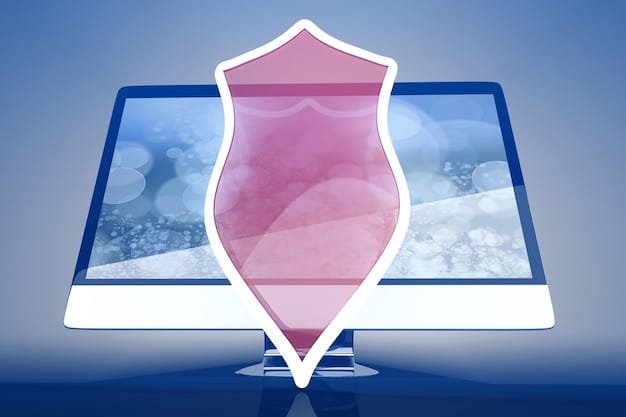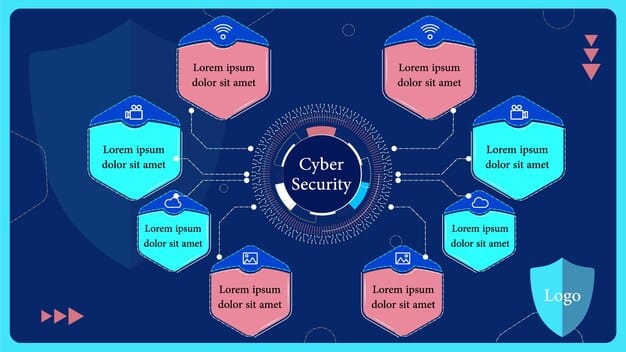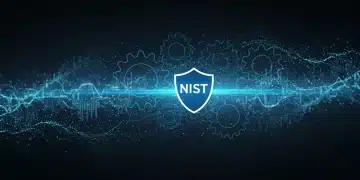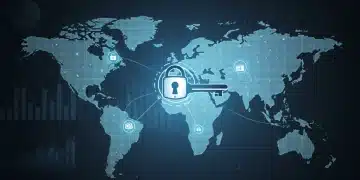Prepare Your Company for NIST Cybersecurity Framework 2.0 in 2025

Is Your Company Prepared for the Updated NIST Cybersecurity Framework 2.0 in 2025? Understanding and implementing the NIST Cybersecurity Framework 2.0 is crucial for mitigating cyber threats, protecting sensitive data, and ensuring regulatory compliance, making proactive preparation essential.
As we approach 2025, the cybersecurity landscape continues to evolve, bringing new challenges and requirements for businesses. Among these, the updated **NIST Cybersecurity Framework 2.0** stands out as a critical standard for organizations aiming to bolster their defenses and protect against increasingly sophisticated threats.
Understanding the NIST Cybersecurity Framework
The NIST Cybersecurity Framework (CSF) is a set of guidelines and best practices designed to help organizations manage and reduce cybersecurity risks. Developed by the National Institute of Standards and Technology (NIST), the CSF provides a flexible, risk-based approach that can be tailored to meet the specific needs and requirements of different organizations, regardless of their size or industry.
Core Components of the NIST CSF
The NIST CSF is structured around five core functions that provide a high-level, strategic view of the lifecycle of an organization’s cybersecurity risk management.
- Identify: Developing an organizational understanding to manage cybersecurity risk to systems, assets, data, and capabilities.
- Protect: Developing and implementing appropriate safeguards to ensure delivery of critical infrastructure services.
- Detect: Developing and implementing appropriate activities to identify the occurrence of a cybersecurity event.
- Respond: Developing and implementing appropriate activities to take action regarding a detected cybersecurity incident.
- Recover: Developing and implementing appropriate activities to maintain plans for resilience and to restore any capabilities or services that were impaired due to a cybersecurity incident.
These functions are further broken down into categories and subcategories, providing a detailed framework for organizations to assess their current cybersecurity posture and identify areas for improvement. The framework also references existing standards, guidelines, and practices, allowing organizations to leverage established resources and best practices.
In summary, the NIST Cybersecurity Framework offers a structured and adaptable approach to managing cybersecurity risks, making it an invaluable tool for organizations looking to enhance their security posture and protect their valuable assets.
Why the Update to Version 2.0?
The cybersecurity landscape is constantly evolving, with new threats and vulnerabilities emerging at an alarming rate. Recognizing the need to keep pace with these changes, NIST has updated the Cybersecurity Framework to version 2.0. This update is designed to address several key areas and ensure that the framework remains relevant and effective in the face of modern cybersecurity challenges.
Key Improvements in Version 2.0
NIST Cybersecurity Framework 2.0 aims to enhance flexibility, clarity, and usability. It does so by incorporating enhancements that clarify terminology, streamline implementation, address emerging threats, and recognize the changing risk landscape.
- Expanded Scope: The updated framework broadens its scope to include all types of organizations, not just critical infrastructure. This recognizes that all organizations, regardless of size or sector, face cybersecurity risks and can benefit from a structured approach to managing them.
- Supply Chain Risk Management: The framework places greater emphasis on managing cybersecurity risks throughout the supply chain. This reflects the growing recognition that organizations are only as secure as their weakest link and that vulnerabilities in the supply chain can have cascading effects.
- Improved Usability: NIST has made several improvements to the framework to make it easier to understand and implement. This includes clarifying terminology, providing more detailed guidance, and developing new tools and resources.
By addressing these key areas, the NIST Cybersecurity Framework 2.0 aims to provide organizations with a more comprehensive and effective approach to managing cybersecurity risks in an increasingly complex and dynamic threat environment. Adopting these updates prepares companies to handle the cybersecurity challenges of 2025 and beyond.

Assessing Your Current Cybersecurity Posture
Before implementing the updated NIST Cybersecurity Framework 2.0, it is essential to assess your organization’s current cybersecurity posture. This assessment will help you understand your strengths and weaknesses, identify areas for improvement, and prioritize your efforts.
Conducting a Gap Analysis
A gap analysis involves comparing your current cybersecurity practices against the recommendations outlined in the NIST CSF 2.0. This process will reveal areas where your organization is meeting or exceeding the framework’s requirements and areas where there are gaps.
To conduct a gap analysis, you can use the NIST CSF 2.0 as a benchmark and evaluate your organization’s current practices across each of the five core functions: Identify, Protect, Detect, Respond, and Recover. This may involve reviewing policies, procedures, and technical controls; conducting interviews with key personnel; and performing vulnerability assessments and penetration testing.
Here are some questions to consider during the assessment:
- What assets does our organization need to protect?
- What are the potential threats to those assets?
- What security controls do we currently have in place?
By conducting a thorough assessment, you can gain a clear understanding of your current cybersecurity posture and develop a roadmap for implementing the updated NIST Cybersecurity Framework 2.0.
Overall, assessing your current cybersecurity posture is a critical first step in preparing for the adoption of the framework. It provides the insights necessary to prioritize efforts, allocate resources effectively, and ensure that your cybersecurity strategy aligns with organizational goals and industry best practices.
Implementing NIST Cybersecurity Framework 2.0
Once you have assessed your current cybersecurity posture, the next step is to implement the NIST Cybersecurity Framework 2.0. This involves developing and implementing a cybersecurity plan that aligns with the framework’s recommendations and addresses the gaps identified in the assessment phase.

Developing a Cybersecurity Plan
A cybersecurity plan should outline specific goals, objectives, strategies, and timelines for improving your organization’s cybersecurity posture. It should also define roles and responsibilities and allocate resources to ensure that the plan can be effectively implemented.
When developing your cybersecurity plan, consider the following:
- What are your organization’s key business objectives and priorities?
- What are the specific cybersecurity risks and threats that your organization faces?
- What are the applicable legal and regulatory requirements?
By aligning your cybersecurity plan with business objectives, addressing specific risks, and complying with legal and regulatory requirements, you can ensure that your cybersecurity efforts are effective and contribute to the overall success of your organization.
Furthermore, the plan should encompass the five core functions of the NIST CSF, detailing how each function will be addressed within your organization. This includes specifying the processes, technologies, and training programs that will be implemented to protect assets, detect incidents, respond to threats, and recover from breaches.
Integrating NIST CSF 2.0 with Existing Systems
Integrating the NIST CSF 2.0 with existing systems is a critical step in ensuring a robust and effective cybersecurity posture. This integration requires a strategic approach to align the framework’s recommendations with an organization’s current infrastructure, policies, and procedures.
Begin by mapping existing security controls and practices to the relevant functions, categories, and subcategories of the NIST CSF 2.0. This mapping process helps identify where current systems already comply with the framework and where gaps exist. It also provides a foundation for building a comprehensive cybersecurity plan that integrates seamlessly with ongoing operations.
Implementing the NIST Cybersecurity Framework 2.0 is a crucial step in ensuring that your organization is prepared to face the cybersecurity challenges of 2025 and beyond. By following the steps and using these tips, you can develop and implement a cybersecurity plan that is tailored to your organization’s unique needs and priorities.
Training and Awareness Programs
Effective cybersecurity is not just about technology; it’s also about people. Training and awareness programs are essential for educating employees about cybersecurity risks and empowering them to take proactive steps to protect your organization.
Creating a Culture of Cybersecurity
A culture of cybersecurity starts with leadership commitment and extends to every employee in the organization. It involves fostering a shared understanding of cybersecurity risks and promoting a sense of responsibility for protecting company assets.
Here are some tips for creating a culture of cybersecurity:
- Communicate regularly about cybersecurity risks and best practices.
- Provide ongoing training and awareness programs.
- Encourage employees to report suspicious activity and potential security incidents.
By creating a culture of cybersecurity, you can empower employees to become your first line of defense against cyber threats. Employees who are aware of the risks and understand their responsibilities are more likely to follow security protocols, recognize phishing attempts, and report suspicious activity.
Regularly Reviewing and Updating Your Framework
Cybersecurity is an ongoing process, not a one-time project. To ensure that your cybersecurity posture remains effective, it is essential to regularly review and update your implementation of the NIST Cybersecurity Framework 2.0.
Staying Informed About Emerging Threats
The threat landscape is constantly evolving, with new threats and vulnerabilities emerging all the time. To stay ahead of the curve, it is essential to stay informed about emerging threats and trends and to adapt your cybersecurity practices accordingly.
Here’s how:
- Monitor industry news, blogs, and social media channels for updates on cybersecurity threats.
- Participate in information-sharing forums and communities.
- Conduct regular threat intelligence assessments.
| Key Point | Brief Description |
|---|---|
| 🛡️Understand NIST CSF 2.0 | Framework’s updated functions and benefits. |
| 🔍 Assess Current Posture | Identify gaps in cybersecurity practices. |
| 📝 Develop a Plan | Create and implement a tailored cybersecurity plan. |
| 🧑🏫 Training Programs | Educate employees on cybersecurity risks. |
FAQ
▼
It’s a set of standards created by NIST to help organizations manage and mitigate cybersecurity risks through guidance and best practices.
▼
All organizations, regardless of size or industry, can use the framework to manage and reduce cybersecurity risks. It is applicable universally.
▼
Your cybersecurity plan should be reviewed and updated regularly, at least annually, or more frequently if there are significant changes.
▼
The core functions are Identify, Protect, Detect, Respond, and Recover, providing a comprehensive approach to managing cybersecurity risks.
▼
Training creates a culture of security, increasing employee awareness, which helps in recognizing and minimizing cyber threats. It promotes responsibility.
Conclusion
Preparing for the updated NIST Cybersecurity Framework 2.0 in 2025 is a strategic imperative for organizations aiming to protect their assets, maintain stakeholder trust, and ensure long-term viability. By taking proactive steps to assess current postures, implement necessary updates, and foster a culture of cybersecurity awareness, companies can effectively navigate the evolving threat landscape and stay ahead in the realm of cybersecurity.





